Are you looking for the best spray primer for painting miniatures? Aerosol or rattle can spray primers vary widely depending on the application. The best spray primers for plastic, metal, or resin miniatures all have three things in common. Great spray primers smooth out surface imperfections without distorting or obscuring details, and they help paint stick. Compared with brush-on primers, spray primers have a speed advantage and are easy to use under the right conditions.
In this article, I share with you my top 7 recommended spray primers for painting miniatures and models. These aerosol primers all work great depending on what you need to do for your mini painting project. I also share pro tips on how to achieve the best results with each of these primers.
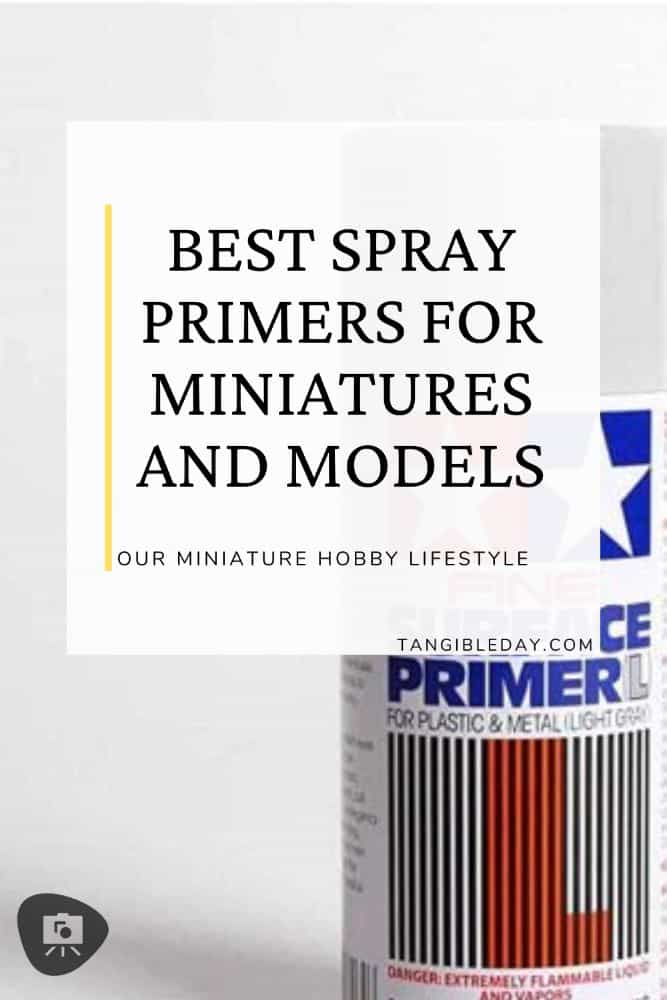
Key Points
- The best spray primer for miniatures will coat evenly, retain fine surface details, and dry with a flat finish that strongly adheres to overlying paint
- For best results with spray primers, apply them to your models in optimal ambient conditions, which including humidity that is less than 55% and close to room temperature, if possible
- Black and gray spray primers produce more reliable finishes than white colored primers
Why Do You Need to Prime Miniatures?
Priming models is the most important early step for painting miniatures.
All plastic, metal, or resin miniatures have imperfections and microscopic defects on their surfaces, which can negatively affect any paint job. An issue with mass produced miniature kits is that the material composition also tend to stick poorly to acrylic paint.
To avoid peeling, chipping paint, a primer acts as a “bridge” between the miniature surface and your overlying paint job. You don’t need a lot of primer to form this interface, as a thin layer will work to help your modeling paint stick.
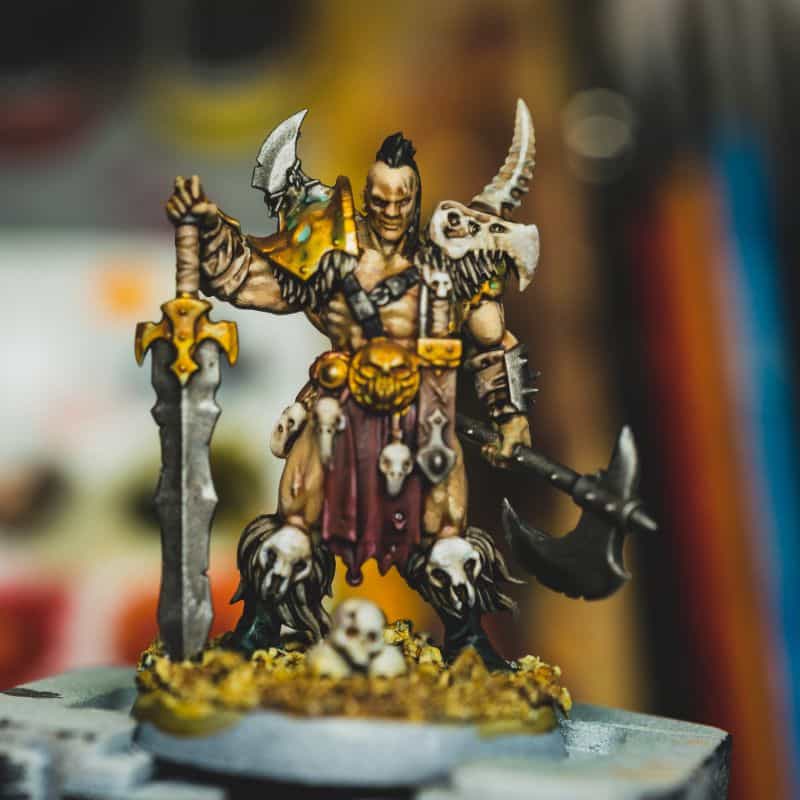
READ MORE: OTHER GREAT PRIMERS FOR PAINTING MINIATURES AND MODELS (FULL REVIEW AND GUIDE)
Because primers have a different formulation than paint, a layer of primer will tend to shrink over a miniature’s surface. This helps fill in and smooth out microscopic bumps that can interfere with painting.
Moreover, the best spray primers will also give you an even matte surface to paint on top of. The matte finish of a good primer is non-reflective, and adds “tooth” or bite to a model’s surface. This makes paint application and color blending easier and more enjoyable.
Best Color for Spray Primers?
Black and gray colored primers are the most reliable primers in my decades long experience working as a commissioned painter. If in doubt, go with black primer as it will give you fewer unpleasant surprises. In my experience, the lighter colored primers are more finicky with ambient temperature and humidity conditions.
In particular, white primers are have issues with clumping or clogging nozzles when the metal can is old, poorly shaken, or when the temperature is too cold. Be careful spraying with white primer. My recommendation here is to always spray your primer on a piece of cardboard or other disposable surface before applying it to your model.
Ultimately, you’ll notice that the spray primers I highlight below do not include any white primers. Rather, I emphasize that when it comes to rattle can aerosol primers, you choose black or gray. If you want to use white or other brightly colored primers, then check out non-aerosol spray primers, which you apply with an airbrush or a regular brush.
Bottomline: Black or gray are the best colors for spray primers in miniature and model painting projects. This is especially true if you want to paint efficiently and quickly without sacrificing quality.
Which Should I Choose? Aerosol or Airbrush Surface Primers?
When it comes to spraying primers on miniatures, you can either use an aerosol primer or a surface miniature primer you can apply with an airbrush. Both types of spray primers have their pros and cons.
Aerosol Spray Primers
Pros
- Convenient
- Less clean up
- Requires less skill
- Accessible
Cons
- Sensitive to environmental conditions
- Less control over spray pattern
- Potential environmental hazard, harmful
- More expensive compared with airbrush or brush on surface primers
An aerosol primer is convenient and easy-to-use. In fact, if you are new miniature painter, you should start with a an aerosol primer. All you need to do is shake the can well, remove the cap, test the spray pattern, and apply it to your model. Tamiya Surface Primers are a universally respected spray primer for pro scale modelers and hobbyists.
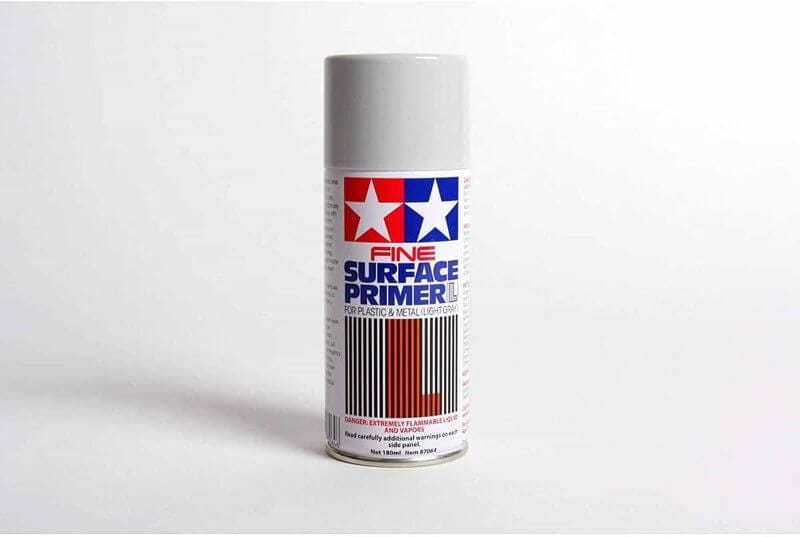
Of course, the disadvantage of an aerosol surface primer is that they are temperamental. They require that you monitor the ambient temperature and humidity.
In cold weather, for example, a spray primer will produce poor results on your miniatures. In high humidity (>50-70%), a spray primer will also give you trouble. There are workarounds for these issues, which you can read about in this miniature primer article.
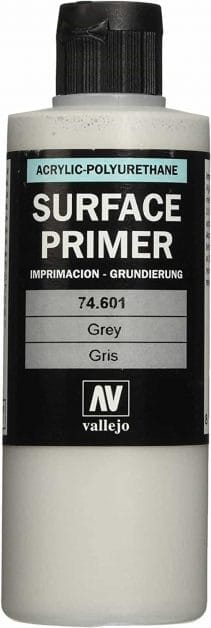
If you can afford and comfortably use an airbrush, then I would suggest using a surface primer rather than an aerosol primer. Airbrush primers like Vallejo Surface Primer will save you money in the long term, and produce similar results as aerosol primers in a safer and more reliable manner.
But, if you’re looking for a compact, convenient, and accessible spray primer for models–and understand the conditions required for best results–then an aerosol primer will be a great choice.
What About 2-in-1 Filler and Primer Sprays?
Some primers contain a filler material that help “fill-in” larger scratches, dents, or even gaps on the working surface. Filler primers are common in the automotive industry, e.g., automotive primers, especially when a car body shop needs to perform cosmetic work on the damaged siding of a vehicle.
When it comes to miniatures, there are a few times when you’d want to use a 2-in-1 spray filler and primer. In the first case is when your model is really large, such as a terrain piece or a DIY model made with different materials. A spray spray filler and primer can help you smooth out the surface in preparation for paint.
Because the models are large, any loss of surface texture or detail due to the filler is negligible. You may even want to cover up gaps or textures on your miniatures. Here, applying a filler primer is a ideal early step for your modeling and painting project.

If you’re planning to paint a 3D printed model or miniature, then a sandable filler primer like Duplicolor automotive primer is a great way to smooth out those build layer lines. They are also less expensive per volume unit than compared with model hobby grade spray primers, e.g., Tamiya or Testors surface primers.
Overall, the best spray primers for 3D printed miniatures, especially those with fused-filament deposition (FDM) build lines, are automotive 2-in-1 filler and sandable primers.
How Do You Use a Spray Primer?
You should always make sure you apply an aerosol primer at the right temperature, which is around room temperature (approximately 24C or 75F). Your ambient relative humidity should be less than 50%, which will help you avoid issues with primer clumping on your model as it dries. Here are other useful tips for priming miniatures.
To apply a modeling spray primer, follow these five steps:
- Open the cap
- Shake the can well, listening for the agitating ball inside the metal can. Make sure you can hear the “rattle”, which means that the agitating ball is freely mixing inside primer can. A dull rattle sound means the primer isn’t mixed well enough.
- Check that the spray is working well. Point the nozzle at a piece of cardboard or other surface, and spray a short burst. You should see an even coat of primer that builds up predictably on the surface.
- Hold the nozzle about 6-12 inches away from your miniatures, and spray using short bursts, sweeping the nozzle back and forth to avoid the primer from pooling in any single area.
- Continue until your entire miniature is coated in a thin layer of primer. Repeat from step #2, if necessary.
When you finish priming, allow the primer coat to dry completely. A good quality primer will have a wet sheen that dries into a matte finish (i.e., a non-reflective surface). To speed up the drying process, you can use a hair blow dryer set to the lowest heat setting.
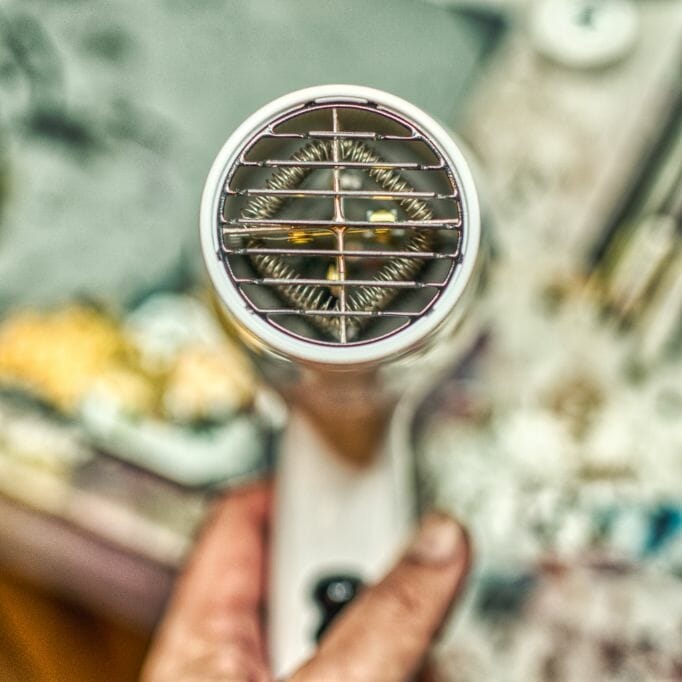
To underscore the use of a hair dryer, I highly recommend any miniature painter have a hairdryer near their workstation. A hairdryer has so many uses! If you’re waiting for your first layer of airbrush primer to dry, for example, a hair dryer can be used to speed up the process. Nobody likes watching paint dry…
Best Spray Primer for Miniatures and Models?
If you’re planning to paint wargaming miniatures or scale models, such as for Warhammer 40k, dioramas, historical military figures, or RPGs, e.g., Dungeons and Dragons, then you’ll want to start with a good primer. A well primed model with be easier to paint, have a more durable finish, and produce better looking final results.
Here are the 7 spray primers I recommend for painting miniatures and models:
- Rust-Oleum 2x Ultra Cover Flat Gray Primer
- Rust-Oleum Automotive 2-in-1 Filler & Sandable Primer
- The Army Painter Color Primer (Matt Black)
- Tamiya Surface Primer (Light Gray)
- Testors Spray Enamel Paint Primer
- AK-Interactive Fine Primer Black Spray
- Krylon ColorMaster Ultra Flat Primer
Continue reading below to see my thoughts and review about these aerosol spray primers for miniatures and models!
As a universal primer for applying paint, Rust-Oleum Flat Gray Primer is a popular choice among modelers and miniature painters. In my experience, almost all Rust-Oleum primers work well on miniatures with a few caveats. You should be aware that general surface primers do not produce the finest applications.
If you’re not careful to spray these primers in short bursts from at fair distance away (6-12″ from the model), they can quickly build-up on your model block out fine details on your miniature. The nozzle on these primers tend to allow a lot more primer to atomize, so you also have less control. With practice, however, you can learn how to spray these onto small surface areas with good results.
Because the aerosol tends to release a lot of primer at once when you press the nozzle, it is best used on larger miniatures, such as terrain or vehicles, or multiple smaller models, e.g., space marines or troopers, at the same time.
The flat gray color dries with a matte finish that helps paint stick and provides a wonderful toothy surface for applying and blending model paint. Overall, I recommend using Rust-Oleum Flat Gray Primer because it is reliable, produces a great binding surface for paint, and it’s affordable.
Key Features and Best Uses
- Large, inexpensive can of primer
- Flat gray color dries quickly with a durable matte surface that binds well to paint
- Works great on plastic, metal, resin, and even porous surfaces, like wood or MDF
- Spray coverage is excellent, but requires skill to avoid overcoating miniatures
2. Rust-Oleum Automotive 2-in-1 Filler & Sandable Primer

All 2-in-1 Filler & Sandable Primers work well for models or miniatures that need a smoother surface. The formulation in these primers include a filler and spray paint combination that fills in surface imperfections better than what other primers can do. In other words, this primer has a bulking or high-build formula that acts as gap filler.
When sprayed onto a surface, this primer will very rapidly build-up in thickness. After it is dry, you can sand down the primer/filler to create a very smooth surface. Of course, the problem with this primer and filler is that you’ll lose almost all surface details that you may want to keep on your miniatures.
Most 25-35mm scale models have fine details that would disappear with a single coat of automotive 2-in-1 filler and primer. As such, a 2-in-1 filler and primer are best used instead for large DIY modeling projects, e.g., terrain pieces or scratch built models, for coating MDF terrain (which often have fibrous surfaces you want to smooth-out), and 3D printed miniatures and parts.
I have had great results using Rust-Oleum Automotive 2-in-1 Filler & Sandable Primer for preparing my FDM/PLA 3D printed miniatures for paint. FDM style 3D printing produces build lines that can hinder painting and generally look weird on small scale models.
Using a filler and primer combo application allows me to smooth out those artifacts of the 3D printing process. I apply this primer as I would with any other spray primer, then allow it to dry. Because the undercoat is thicker, the build lines tend to always fill-in well.
To finish the application, I will use a piece of sandpaper or file to remove any excess primer for areas I want to retain surface contour. The finished result is smooth and is very nice to paint on. Of course, the more time you spend applying primer and sanding your 3D printed pieces (rinse and repeat, as desired), the better your overall result.
Key Features and Best Uses
- Fills in gaps on a model or miniature’s surface
- Bulking or hi-build formula will create a thick primer surface that you can sand smooth
- Dries quickly with a matte finish that binds well to paint
- Best used on 3D printed models or larger miniatures without a lot of fine surface detail
3. The Army Painter Color Primer (Matt Black)

Hobby grade primers are designed specifically for preparing plastic, metal, or resin miniature kits for paint. The Army Painter Color Primer (Matt Black) is no exception. It is a very popular choice for miniature painters and hobbyists who paint scale models or wargaming models.
Along with Citadel Games Workshop primers, which I’ve used a lot in the past, The Army Painter undercoat is also a convenient rattle spray can primer that works straight from the can. Note that I’ve encountered problems with the white colored primers from these game company branded primers, including clumping finishes and clogged nozzles.
Whether these issues were due to poor temperature, my inexperience, or the spray primer itself, I’ll never know. When it comes to applying lighter colored primers, I gravitate toward Tamiya surface primers (shown below), which have given me a more reliable spray priming experience.
The Army Painter Color Primer (Matt Black) has great coverage and adheres well to metal, plastic and resin miniatures with non-reflective, matte finish. This primer dries quickly, within 10-30 minutes under normal temperature and humidity conditions. The undercoat is durable, in my experience, and does not peel or chip easily.
For those looking to paint miniatures faster and efficiently, starting with a black primer application is the best way to start. Overall, a black primer like The Army Painter Color Primer is a reliable and versatile choice to get your miniature painting project started. Make sure you read the tips highlighted above for best results with this primer.
Key Features and Best Uses
- Great primer for starting any miniature painting project
- This black spray primer helps you paint miniatures quickly and efficiently
- Dries quickly in under 30 minutes
- Produces a durable surface for painting plastic, metal or resin miniatures
4. Tamiya Surface Primer (Light Gray)
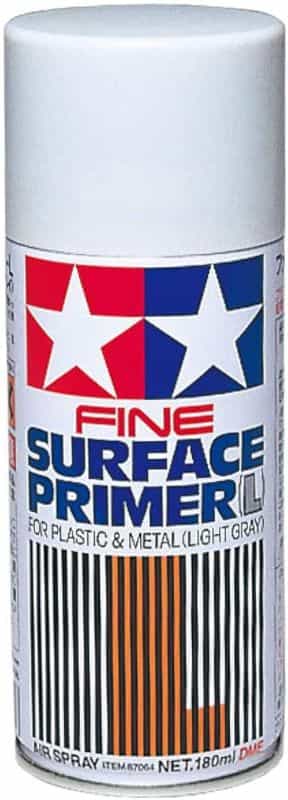
Both Tamiya and Testors are my two favorite hobby companies. They make products that have always worked well for my miniature and scale modeling projects. The Tamiya Surface Primer (Light Gray) is my favorite aerosol primer for preparing miniatures that I want to paint to a professional standard.
Tamiya surface primers are expensive compared with other hobby-grade primers. But, its value comes from the results it helps me produce. These hobby primers do not use the same formula as standard primers. Tamiya primers have a much finer spray application, producing “a mist” that sticks well to plastic or metal miniature surfaces. In fact, I often have to stop in the middle of spraying models to examine whether the primer is actually coating the model.
The fine coating property preserves details on a miniature’s surface, and yet creates an undercoat that binds perfectly to acrylic model paint. Some of my best work started with 1-2 thin coats of Tamiya fine surface primer, which you can see in my miniature painting gallery.
I often recommend the light gray color, because it produces a nice colored tone. You retain good visibility of surface contrast (light and shadow) that can help you paint details with less eye strain.
Note that you may paint models slower starting with a brighter colored primer, e.g., shadows and shade require better paint coverage. But, if you’re not in a rush and want to enjoy the process, the light gray tone is my recommended color for Tamiya spray primers. Finally, if you’re familiar with zenithal priming or highlighting, the Tamiya light gray primer is the one I use when I’m not using my airbrush.
Key Features and Best Uses
- Popular among professional miniature painters and scale modeling hobbyists
- Produces a very fine spray that coats models lightly and effectively
- Great at preserving surface details
- Durable and easy-to-use
5. Testors Spray Enamel Paint Primer

Testors Spray Enamel Paint Primer is the direct competition for Tamiya Surface Primer (shown above in #4). I choose Testors or Tamiya depending on availability and price. Depending on where you live, the price per can of Testors or Tamiya will vary widely online and may be available in your local brick and mortar hobby store.
You can apply both Testors and Tamiya primers the same way, and they produce similar results on miniatures and models. Testors spray enamel works greats for any hobby or crafting project. You can apply a thin coat quickly that will stick to metal or plastic, and provides a durable surface to apply paint.
Of course, I prefer using gray colored primers as they allow me to see surface contrast and details on a miniature before applying paint. Testor spray enamel primers also come in a variety of other colors.
If you can’t find the gray, or want to combine this with a lighter primer for zenithal undercoating techniques, you can also get the black colored Testors spray primer, which also works great.
Key Features and Best Uses
- One of my favorite primers for starting any miniature painting project
- Easy-to-use and dries fast
- Prepares a durable undercoat for painting plastic, metal, or resin miniatures
- Gray color tone helps you see surface contrast and detail
6. AK-Interactive Fine Primer Black Spray
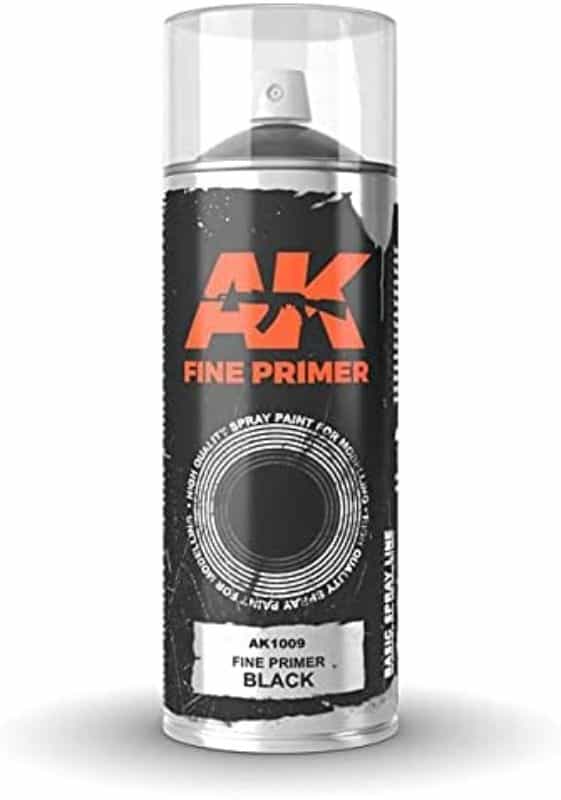
AK-Interactive is a company that makes paints, supplies, and tools for all kinds of scale modeling and miniature hobbies. The AK-Interactive Fine Primer Black Spray works similar to a normal household primer, except it produces a much finer and thinner undercoat on your working model surface.
Their AK fine primer is an ideal primer for preparing any model surface for paint. Like other spray primers, you’ll need to be aware of its limitations.
For best results, shake the can well, spray in short, sweeping bursts over your model, and only use this primer outdoors or in a ventilated spray booth under ideal temperature and humidity conditions.
I find this primer to be a tad expensive. But, note that this is a high quality, fine primer designed to work best for modeling and miniature hobbies. This means it’ll help you preserve details on a model while providing an ideal undercoat surface for painting.
AK-Interactive spray primer (along with a good varnish) will also help your painted models stay resilient against the normal handling and transport of your tabletop gaming miniatures. Less paint chipping or peeling means less work later to fix and repair.
Key Features and Best Uses
- Reliable black primer for models and miniatures
- Dries quickly (under 10 minutes)
- Works great on plastic, metal, and porous surfaces, e.g., wood or MDF
- Helps paint stick to models and prevents chipping and peeling
7. Krylon ColorMaster Ultra Flat Primer

Krylon ColorMaster Ultra Flat Primer is my go to all-purpose primer for any hobby projects where I need a durable undercoat. For scale models, DIY scratch building projects, 3D prints, and miniature wargaming kits, Krylon ColorMaster is a reliable primer for producing smooth surfaces in preparation for paint.
As with other all-purpose standard primers, however, you’ll need to be extra careful when applying them to miniatures. To preserve details, you should use short, sweeping bursts from at least 6-12″ away.
I like Krylon aerosols because they come with nozzles that are easy to control and produce a wider atomized spray pattern than other spray cans.
Of the Krylon ColorMaster primers, I always use the ultra flat gray primer because it helps me see surface contrast and allows me to see accurate paint colors when I apply them to the primed miniature surface. The neutral gray primer doesn’t distort color and dries quickly (under 10 minutes) into a non-reflective, matte surface.
The best thing about Krylon ColorMaster primers is that you can find them in almost any hardware store. They are inexpensive for the size of the can you get and
Key Features and Best Uses
- An all-purpose primer for all kinds of hobby and craft projects
- Comes with a EZ-touch nozzle for fine spray control
- Works well on miniatures with good application technique (e.g., short spray bursts)
- Neutral gray matte color helps you compose paint color with good contrast
Are Spray Primers Safe?
If you’re worried about the health risks associated with using aerosol spray primers, you might be surprised to learn that these products are actually safe when used properly. However, there are some things to take note before you start spraying your miniatures.

The most important thing is to use an adequate amount of ventilation or wear a respirator mask while spraying. You can use a spray booth, but I recommend you only use one that vents flammable aerosols outside your room.
Summary Table
| Image | Product | Features |
|---|---|---|
 | Rust-Oleum Flat Gray Primer |
|
 | 2-in-1 Filler & Sandable Primers |
|
 | The Army Painter Color Primer (Matt Black) |
|
 | Tamiya Surface Primer (Light Gray) |
|
 | Testors Spray Enamel Paint Primer |
|
 | AK-Interactive Fine Primer Black Spray |
|
 | Krylon ColorMaster Ultra Flat Primer |
|
Conclusion
I hope this article gave you insights into my recommended primers that I use in my miniature painting and scale model projects.
The best spray primer for painting miniatures and models will depend on your application. Almost all aerosol primers will stick well to plastic, metal and resin materials. Some primers will fill-in details, while others will do a better job preserving surface details.
Compared with brush-on primers, spray primers are accessible and convenient when you use them under the right conditions. If you have any favorites that you like using for painting miniatures, please let me know!
Happy miniature painting and priming!




Tangible Day on YouTube (Miniatures and More!)


Pingback: Top 10 Primers for Plastic and Metal Miniatures (Reviews and Tips) - Tangible Day
I’m painting some miniature ships using Citadel Contrast colors, which are translucent compared to regular paints. Would you still recommend a darker gray colored primer over a lighter, maybe even white primer? I don’t know how the Contrast colors work over darker base layers. Thanks!
With contrast paints, I would recommend just using a light-colored primer (eg white or light gray). The translucency of the contrast paint works best on top of this light base tone. I would suggest a white or off-white primer to start, for sure. It’ll give you more color space to add contrast through multiple thin contrast paint layers. If you’re not sure, test this on a spare piece of plastic first. Maybe an extra sprue to see how it works before you apply the paint to the model itself.